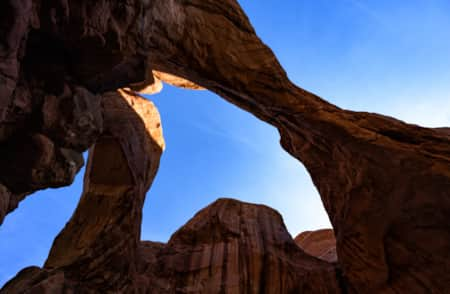"The otherworldly landscape of Arches National Park is a desert dream painted in red sandstone, faded green juniper and pastel twilight sky."

Devil's Garden in Arches National Park

Arches is a certified International Dark Sky Park.

The backcountry at Arches is notoriously rugged and dry.
Backcountry and BLM Camping Near Arches
If you want to delve into the backcountry of Arches National Park, a permit ($7 per person) is required from the visitor center. The backcountry at Arches is notoriously rugged, dry and definitely not beginner-friendly. Human waste must be packed out using an approved commercial bag system (Read: "How to Poop in the Outdoors"). Besides the burly terrain, certain areas of the park are subject to flash floods and lightning storms — be vigilant of the forecast before heading out.
Outside of Arches, Moab has a wealth of Bureau of Land Management land (BLM) that’s just as popular (and often as busy) as Devils Garden. The BLM supports a whopping 26 campgrounds in the Moab area.
The collection of developed sites are $20 per night and most feature vault toilets, fire pits and picnic tables. These range from 4,000 feet above sea level near town to over 6,000 feet at the Cowboy Campground.
The BLM campgrounds are required to be located 20 miles from town, which often means they are actually closer to the famous Moab destinations than in-town lodging. Nearly all are a short 10- to 20-minute drive to Arches National Park.
RV Camping and Glamping
RVs are welcome in the Devils Garden Campground, though getting a reservation can be a challenging affair. Utilizing the numerous RV parks in Moab is just as good an option. They offer RV hookups and easy access to the town itself. (Read: “Wheeling It: An RV Primer for Utah Family Trips”)
There are also several hotels, resorts and even a glamping option in Moab, for those looking for a few more amenities.
Start Planning
-

Arches National Park
Arches National Park contains more than 2,000 natural arches—the greatest concentration in the country. Find places to stay, itineraries, reservation info and weather for Arches, Moab and Canyonlands National Park.
-

Arches National Park Hikes
Arches National Park is one of the most popular hiking destinations in Southern Utah. Start planning your hiking trip with these trails!
-

How to Visit Arches
Arches National Park is a red rock paradise — and also a very popular destination. Discover tips for how to visit responsibly and maximize your enjoyment.
-

Things To Do In Arches National Park
Arches National Park is a vast playground for the adventurous, where everyone can find an unforgettable experience.
-

Winter in Arches National Park
Skip the crowded peak season and embrace the quiet of a winter visit to Arches National Park. Enjoy winter hikes, scenic drives and some of the best stargazing in the world.



















